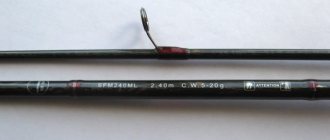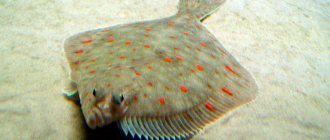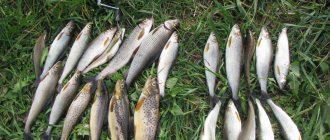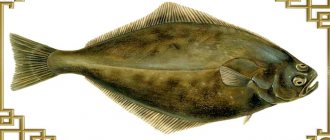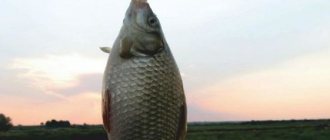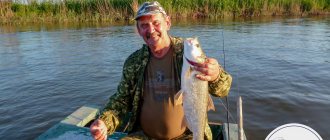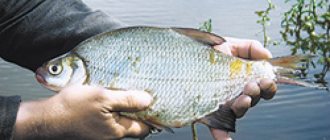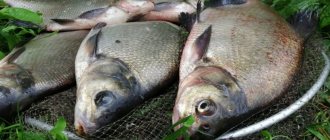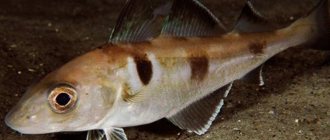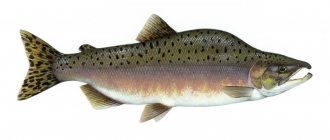Fly fishing is a relatively recently developed type of fishing, which is beginning to spread more and more in Russia. Fly fishing is used mainly for catching fish that feed on insects that fall on the surface of the water. When studying it, you need to remember that this method is completely different from float or spinning fishing, starting from the wiring method and ending with the device of the tackle. And if you can argue about playing with bait and the correct casting technique for hours and not come to a consensus, then in choosing a fishing rod and equipment for it there are certain tips and factors that you can rely on. How to make the right choice of fly fishing rod will be discussed below.
Differences between fly fishing forms
Externally, fly fishing rods can be similar to the usual spinning rods or float rods. But at the same time, in the right fly fishing gear, some characteristics are especially important, which in the same spinning rod do not play a key role. So the light weight and lack of resistance of the cord when casting are put in first place. Another very important factor is wear resistance. During the fishing process, gear is exposed to extreme environmental conditions: the reel and blank are lowered into the water, dropped on the sand, and in some cases, fly fishing can even be carried out in pouring rain.
Therefore, manufacturers pay a lot of attention to protecting gear from moisture and dust. They cover it with waterproof varnish, make the coils from materials resistant to corrosion and friction, and minimize the gaps.
Also, such tackle differs from conventional fishing rods not only in characteristics, but also in structure. Their main difference is that the coil is located almost at the very end. This is done for convenient interaction with the cord. The handles themselves can also be of different shapes. In rods designed for catching large fish, there is a thumb rest on top, and when fishing for small fish, the index finger is placed on top for a more comfortable grip.
Example of fly fishing gear
Distinctive features of fly fishing rods
Fly fishing kits are available for sale in specialized stores. Fly fishing is a method of attracting fish that feed on insects that fall into a body of water. A fly fishing rod is different from other types of fishing rods; its shape is similar to a spinning rod. They make plug-in and telescopic fly fishing rods. The effectiveness of fishing depends on what fishing rod you use.
Fly fishing differences:
- The reel is installed below the handle.
- The shape and dimensions of the handle are different from the standard ones.
- Fly fishing poles, like spinning rods, differ from each other.
- Fly fishing forms vary in material, structure, and length.
A fly fishing reel is a type of inertial reel. When fly fishing, a reel is not used when casting. It is designed for storing backing and cord, as well as for fishing for already caught fish. Reels come in different designs. For each fly fishing rod, select the appropriate reel. If you use a reel that does not match the class of the rod, the tackle will not be balanced. This makes casting worse. Fly reels are available with a variety of brakes.
In lightweight reels designed for catching small fish, a ratchet brake is used, which stops the drum so that it does not spin idle. Reels for fishing for large fish are equipped with a powerful friction brake. It helps in pulling out heavy fish. Some reels have a brake with bearings placed in a hermetically sealed capsule. In this case, water does not enter the drum and the effectiveness of the braking system is not reduced.
Fly fishing differs from spinning in the method of casting bait. When using a spinning rod, the bait flies forward and pulls the cord along with it, as it has a lot of weight. In a fly fishing rod, the weight of the fly is small, so it is impossible to cast a spoon using this method. Casting occurs using a heavy cord, which is cast due to its own weight.
This operating principle has a long whip. Before casting, fishermen accelerate this line with circular strokes of the rod so that it acquires the speed necessary for flight. Cords are divided into different types. They are divided according to their buoyancy into the following types:
- Floating, when the cord floats on the surface of the reservoir. Used for fishing on the surface, underwater or at depth.
- Slightly sinking, when the line gradually sinks into the water. Used for fishing under the surface or at shallow depths, when the mass of the fly is not enough to lower it under water.
- Sinking when the entire line is under water. Used in deep reservoirs.
- Combined: floating with a sinking or slightly sinking end. This cord consists of a main section that floats and a short section that sinks. Used for fishing at different depths depending on the speed of lowering the cord. That piece of cord that floats on the surface makes it easier to control the fishing process.
Length and action
The length of a one-handed fishing rod ranges from 2 m to 3.6 m. If you need longer gear, then choose a two-handed model. The length of the fly rod is chosen depending on the reservoir, fishing method, and the weight of the fish you want to catch. The most universal designs that allow you to catch both large and small fish have a length of 2.4−2.8 m. Such fishing rods are used when fishing with flies. When installing streamers, it is better to choose a fly fishing rod with a length of 2.75-3.2 m. Using small fishing rods, you can fish under tree branches hanging over the pond.
Rods are divided according to their action into fast ones, when the end of the rod bends; medium-fast, when 1/3 of the length is involved; medium, when the fishing rod bends to the middle; slow, which bend over the entire length. Professional fishermen need a strict choice of fishing rod. Amateur fishermen prefer medium action rods with durable backing. Soft action models make it possible to prevent thin line from breaking when fishing for heavy fish of large breeds.
Material of manufacture
The material used to make fly fishing rods can vary. Shops sell fly fishing forms made of wood, fiberglass, laminated bamboo, and carbon fiber. Wooden structures are rarely found in stores. They are no longer produced after the advent of designs made from more durable modern materials. You can purchase a fishing rod made from a special breed of Vietnamese bamboo. The products are split, then glued and polished. The construction is durable. The price of such products is quite high.
Fiberglass rods are strong, but not as lightweight as bamboo rods. But they are cheaper. Carbon fiber ones are distinguished by their low weight, good strength and affordable prices. They are the most popular.
Type of elbow connection
This indicator is not as important as action or length, but it is taken into account. There are different types of connection of the elbows of this product: pin, when a pin is installed on the lower elbow, on which the upper one is placed; fastening with the lower knee entering the area of the upper one.
Classification of fly fishing forms
The first thing a novice angler who wants to buy a fly fishing rod encounters is the classification system for this type of gear. In some sources it may be described in a complex and unclear way. In fact, all you need to know when choosing a fly blank is:
- Class
- Build
- Material from which the tackle is made
- Rod length
- Is it one-handed or two-handed?
More details about which characteristics influence what, and how to choose gear suitable for fishing in specific conditions will be discussed below.
One-handed
Single-handed fly rods are more common among anglers new to fly fishing because they make casting techniques easier to understand. One-handed tackles are shorter and lighter, making them more convenient to use in such conditions. But this does not mean that the skill of an angler depends on whether he uses a two-handed fly rod or not. Both types show good results in different conditions. It will just be easier for a beginner to handle a lighter form.
One-handed
Two-handed
Two-handed ones are designed for catching large fish, so their length and strength are greater than those of one-handed ones. Due to the size of the fishing rod, a beginner may have problems using it. It will be especially difficult to cope with it in a confined space (in small bodies of water, overgrown on all sides with trees, bushes and other vegetation). Therefore, if there are no open bodies of water nearby where you can safely practice casting bait, then it is better not to take a two-handed one.
Another difference between two-handed ones is that they allow casting over longer distances. The second hand at the moment of casting the bait will more accurately control the movement and provide more force.
Two-handed fly fishing
Fishing Features
The features of this method are:
- Rod design.
- No float or sinker.
- Instead of fishing line and strings, special cords of various shapes are used.
- Rod length.
- The ability to independently make bait for specific fish.
- Perfect casting technique.
- As a rule, a fisherman stands in the water, so a special suit is additionally required.
- Cord control is important.
Let us consider schematically the components of the equipment.
Plug rods from two sections are used. There is a telescopic format, but it is not popular. To maintain balance, the reel seat is located near the handle itself; this is the main distinguishing feature.
Features of the equipment require a thorough and thoughtful approach to the choice of gear. Before going to the store, decide: who you plan to fish for, what flies, the fishing location, including the individual characteristics of the reservoir and coastline. Pay attention to the following indicators of the form: class, structure, length. In addition, you should take into account the material of manufacture, the shape of the handle, and the quality of the guide rings.
Class
The class of a fly fishing rod is one of the main characteristics when choosing it. It depends on the weight of the cord it will work best with. When calculating, the weight of the first nine meters is considered. Essentially, the higher, the greater the load the tackle can withstand and the further it allows you to cast the bait.
Since the birthplace of this type of fishing is America, it was there that a unified measurement system appeared. Initially, there were only 15 classes, from 1 to 15. Later, extra heavy level gear was added (16, 17, 18), and then extra light gear (0, 00 and 000). It turns out that now there are 21 classes of fly fishing gear. The most commonly used are 4-8. The further the class goes in one direction or the other, the more focused the form becomes.
To select the correct cord for the form, you can use this table:
Table of the relationship between rod class and cord class
Gear class from “000” to “2”
The rods are very light, used only when catching small specimens on small lakes and streams with a slow flow. The baits used are small in size, which means you need to fish in shallow water. Due to its low weight and short length, it is very difficult to control such gear. Any external factor will greatly affect the flight of the bait, be it a blow of wind or a slightly trembling hand. Since fishing with a blank of this class occurs most often in forest streams, deviation of the flight of the line can greatly spoil the fishing experience, especially if the fly flies into the bushes or gets caught on a tree branch.
From "3" to "4"
Essentially a mid-range between light and medium. Although it can withstand more loads, it is unlikely to catch a trophy with it. This form is easy to use, listens well when casting and forgives some mistakes. Therefore, when choosing your first fly fishing rod, you can dwell in more detail on this option.
5th and 6th grades
These are average, among all they are the most universal. This type of length ranges from 2.1 meters and above. You can catch medium-sized fish with them, and if an experienced angler fishes, he will be able to cope with the bite of really large fish. These can be fished with any bait: dry or wet fly, light streamer and others. However, it is not worth attaching flies more than 5 centimeters in length for this class.
Tackle from "7" to "9"
These are already considered heavy. The cord that is used for fishing with such a rod already has enough weight to make long casts, so usually this type of gear is used for fishing in large open bodies of water (wide rivers, lakes). They can also already be used for fishing in the coastal sea zone. These forms are designed for catching large fish, so putting light dry flies on them will not work.
Class "10" and above
All rods that have a class above ten are intended for fishing at sea. They use the heaviest weight lines and the largest size baits. At the end of the handle, such fishing rods usually have a special stop so that the angler can rest the form against his body when fishing for a trophy that is too large. Often, experienced fishermen will notice that their gear is slightly altered. Most often, changes concern the handle. The fishermen themselves modify it so that it fits perfectly in the hand.
Rod length
The length of a fly fishing rod, depending on the class and fishing conditions, can be from 2.1 meters to 3.6 meters .
The lightest fishing rods up to power class “2” are rarely longer than 2.1 meters . This ensures a harmonious combination of the weight of the rod and the weight of the line used with the bait. It is also rational to choose fishing rods of this length when fishing from a boat.
Forms from “3” to “6” classes are offered in lengths from 2.1 to 2.7 meters . From this category, it is best to choose a fly fishing rod for beginners. The optimal length for learning fishing techniques will be 2.4 meters.
Sticks of heavy classes, from “6” and above , can be up to 3.4 meters . They can already provide long-distance casting of heavy baits. Some advanced fly fishermen, in order to make ultra-long casts, make their own fly fishing rods of even greater length (up to 4 meters).
Construction of forms
Another important characteristic when choosing is the structure. It directly affects the performance of the fishing rod during any action: casting, hooking, playing fish. Action shows how much of the rod bends under load. The slower the action, the longer the rod length works. Now there are such systems:
- Fast build. When under load, only the end of the tackle works. Among all, this one is the toughest. They can make accurate long casts even in strong winds. A cord with a narrow loop is used with this form. Typically, this type of fishing rod is purchased by experienced fishermen who have a well-developed technique for casting bait. English title – “Fast Action”
- Medium-fast action. With forms of this type, only the third part bends under load. This rod is best used for fishing with large weight lures. It allows you to make accurate casts over long and medium distances. As with fast action, they also often use a narrow loop. The English name of the system is “Moderate Fast”
- Medium build. This tuning gets its name because its curve from the middle to the tip most closely resembles a parabola. This type of blank is designed for fishing at short or medium distances. Because of its versatility, tackle of this type can often be found among novice fishermen. English title – “Moderate Action”
- Slow build. When working with such a form, the entire body bends. It forgives many mistakes when casting and allows you to throw the fly exactly where you want. It is best to fish with them in calm weather at short distances. English title: "Medium-slow"
Build
Designations on the rod blank
Like spinning rods, fly fishing rods also have designations on the form. For example "SM2 1469/4". In this inscription, the letters “SM2” indicate the model. The first three digits of "146" are the length in feet (14'6''). The number “9” shows the class, and “4” is the number of sections that make up the fly fishing rod.
Fly fishing markings are always intuitive and contain basic information about the form. Over time, any angler begins to understand the main characteristics of the gear with one glance at the name and appearance.
Designations on fly fishing gear
Marking
Fly fishing forms contain markings by which you can determine its parameters and characteristics. Different manufacturers of fly fishing rods may label the product differently. But there are common features in all markings. Let's find out what the marking means: SB 965/3 9'4"/#6 Line 3.80 Oz.
SB 965 is the name of fly fishing; 3 - means the number of tribes; 9'4" - shows length in feet and inches; #6 Line - indicates power class; 3.80 Oz - shows the weight of the rod in ounces. Buyers will be able to use the available markings to choose a fishing rod that suits them in terms of price, quality, length parameters, action, etc. If all the parameters of the gear are chosen correctly, then an excellent catch is guaranteed.
Basic recommendations when choosing gear
When choosing gear for fly fishing, you should rely on the advice of experienced anglers and the conditions in which the fishing will take place. It’s better not to listen to a consultant in a store, because his advice, most often, is based not on real experience of using the form, but on the numbers on the price tag. You can determine fishing conditions by looking at the map. If there are only small bodies of water nearby, hidden somewhere in the forest, the choice is made towards compactness and lightness, that is, rods no higher than 4. And vice versa, if there is a sea or a large lake nearby, you can buy a 7-9 class form. Between a one-handed and two-handed model, it is better to choose the first one, it is more versatile and easier to use.
catching
If you cannot correctly determine the conditions for future fishing, you can ask local fishermen about them.
The most important thing when choosing gear is to realize that fly fishing is completely different from fishing with the same spinning rod. There are different brands and different priorities here.
Build
As befits any fishing rod, fly fishing models are also classified according to their structure into:
- fast, where only the tip of the rod bends;
- medium-fast, in which the upper third works;
- medium, bending from the middle of the form;
- slow, curving along the entire length.
Careful selection of a rod according to its action is important for a true professional. Amateurs most often use medium-length blanks.
